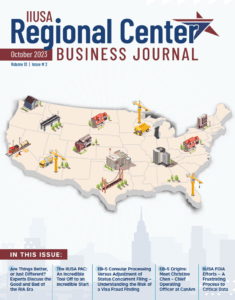by Robert Divine, Shareholder, Baker, Donelson, Bearman, Caldwell & Berkowitz, P.C. and Kathleen Harrison, Associate, Baker, Donelson, Bearman, Caldwell & Berkowitz, P.C
On August 24, 2018, USCIS issued a revised Volume 6 of its Policy Manual which concerns EB-5 investors with a summary of the update here. The revisions finalize and clarify policy on the economic methodologies used in connection with regional centers, a regional center’s geographic area, including requests to expand geographic area, and the implications of a regional center change or termination.
USCIS has not published a document showing what the actual changes are, but I have run a comparison to detect the changes. Further below I quote the changes, but immediately below I summarize them and provide some commentary.
Policy Content and Implications
Economic Methodologies Used in Connection with Regional Centers
Summary: USCIS will consider the multipliers and assumptions about the geographic impact of the project in determining whether an economic methodology is reasonable. When reviewing the geographic level of the multipliers used, USCIS may consider the area’s demographic structure (including labor pool supply, work force rate, population growth, and population density), the area’s contribution to supply chains of the project, and connectivity with respect to socioeconomic variables in the area (such as income level and purchasing power), among other factors.
Implications: USCIS assessment is of the reasonableness of economic methodologies is based on various factors, which provides flexibility to regional centers but no clear limits. It is not clear what USCIS is trying to do here, and the Policy Manual still states that “[i]ndirect jobs can qualify and be counted … even if the jobs are located outside of the geographic boundaries of a regional center,” but it is conceivable that USCIS may use this new language not to credit national impact jobs used by economists with certain methodologies.
A Regional Center’s Geographic Area
Summary: A regional center’s geographic area must be limited, contiguous, and consistent with the purpose of concentrating pooled investment in defined economic zones. To show the area is “limited,” the regional center should show that linkages between proposed economic activities within the proposed area, such as regional connectivity, labor pool and supply chain, and interdependence between projects. In assessing the likelihood that the proposed economic activity will promote economic growth in the proposed geographic area, USCIS will consider the impact of the activity relative to relevant economic conditions. In other words, the size of the area should be consistent with the scope of the project.
Implications: It is not clear whether or how USCIS might use this language to narrow the geographic scope of new regional center requests. The addition of “interdependence between projects” as a consideration could mean that USCIS might not allow regional centers to patch together huge areas based on a combination of unrelated types of projects.









